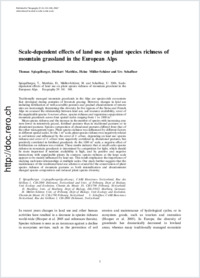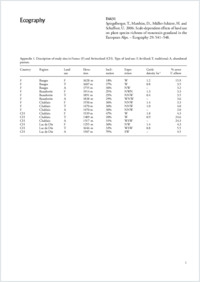Scale-dependent effects of land use on plant species richness of mountain grassland in the European Alps
- Spiegelberger, Thomas University of Fribourg, Department of Biology, Unit of Ecology and Evolution, Switzerland - CABI Bioscience Switzerland, Delémont, Switzerland
- Matthies, Diethart University of Marburg, Department of Biology, Marburg, Germany
- Müller-Schärer, Heinz University of Fribourg, Department of Biology, Unit of Ecology and Evolution, Switzerland
- Schaffner, Urs CABI Bioscience Switzerland, Delémont, Switzerland
-
2006
Published in:
- Ecography. - 2006, vol. Volume 29, p. 541-548
English
Traditionally managed mountain grasslands in the Alps are species-rich ecosystems that developed during centuries of livestock grazing. However, changes in land use including fertilisation of well accessible pastures and gradual abandonment of remote sites are increasingly threatening this diversity. In five regions of the Swiss and French Alps we assessed the relationship between land use, soil resource availability, cover of the unpalatable species Veratrum album, species richness and vegetation composition of mountain grasslands across four spatial scales ranging from 1 to 1000 m².Mean species richness and the increase in the number of species with increasing area were lower in intensively grazed, fertilised pastures than in traditional pastures or in abandoned pastures. Species composition of abandoned pastures differed from that of the other management types. Plant species richness was influenced by different factors at different spatial scales. At the 1 m² scale, plant species richness was negatively related to soil nitrate and influenced by the cover of V. album, depending on land use: species richness and cover of V. album were negatively correlated in abandoned pastures, but positively correlated in fertilised grasslands. At the 1000 m² scale, a negative effect of fertilization on richness was evident. These results indicate that at small scales species richness in mountain grasslands is determined by competition for light, which should be more important if nutrient availability is high, and by positive and negative interactions with unpalatable plants. In contrast, species richness at the large scale appears to be mainly influenced by land use. This result emphasizes the importance of studying such inter-relationships at multiple scales. Our study further suggests that the maintenance of the traditional land use scheme is crucial for the conservation of plant species richness of mountain pastures as both intensification and abandonment changed species composition and reduced plant species diversity.
- Faculty
- Faculté des sciences et de médecine
- Department
- Département de Biologie
- Language
-
- English
- Classification
- Biological sciences
- License
- License undefined
- Identifiers
-
- RERO DOC 6061
- DOI 10.1111/j.0906-7590.2006.04631.x
- Persistent URL
- https://folia.unifr.ch/unifr/documents/300085
Other files
Statistics
Document views: 138
File downloads:
- mullerschaerer_sde.pdf: 185
- mullerschaerer_sde_o.pdf: 119

